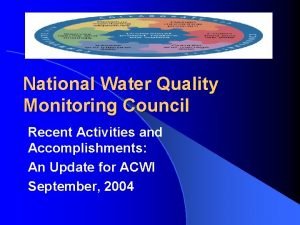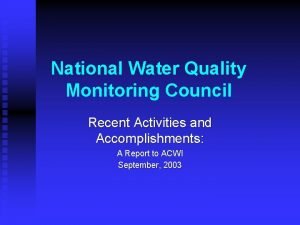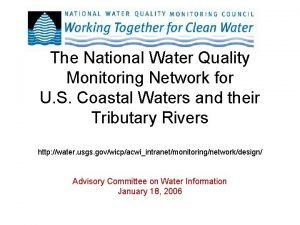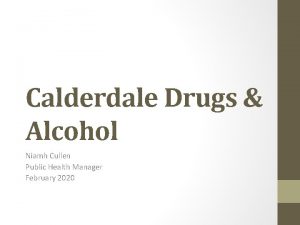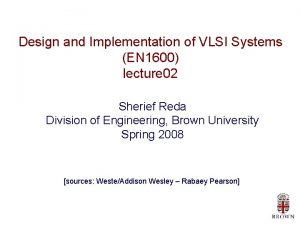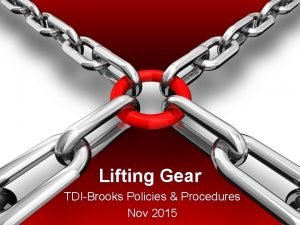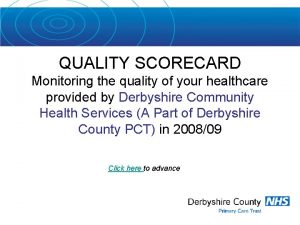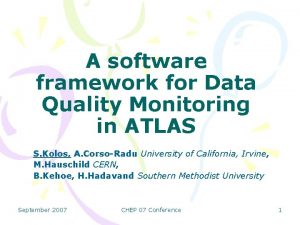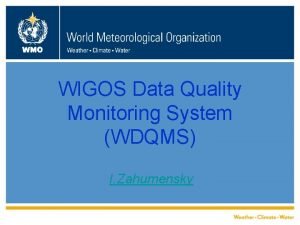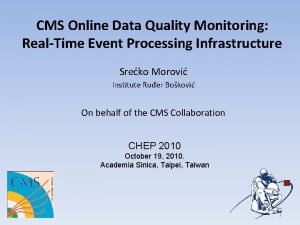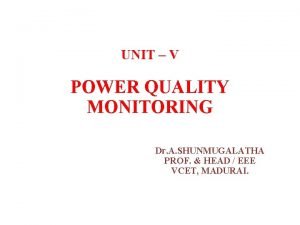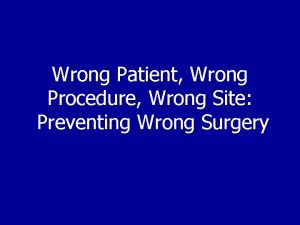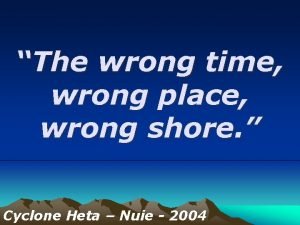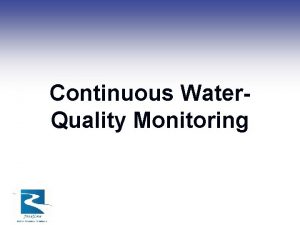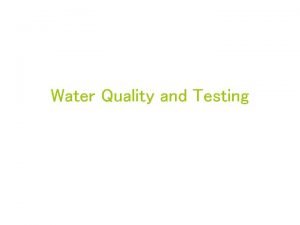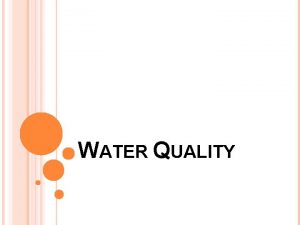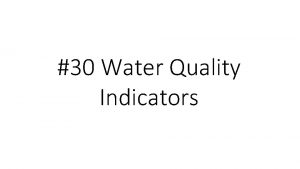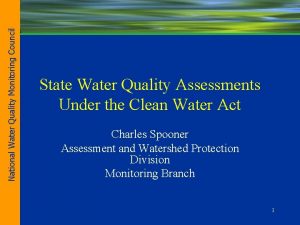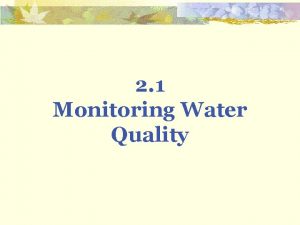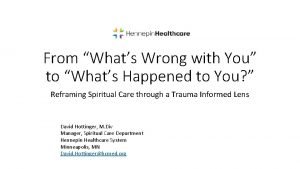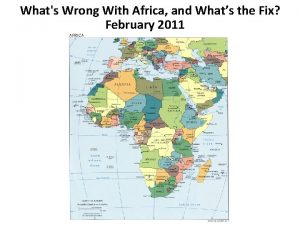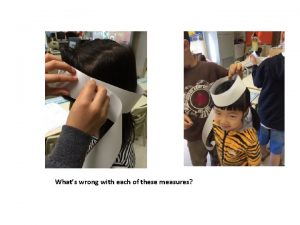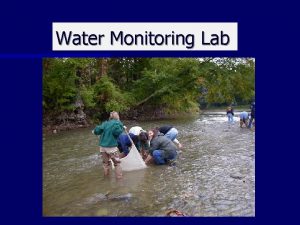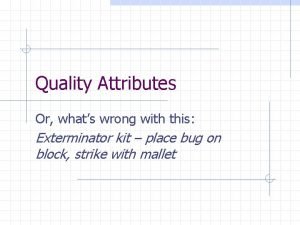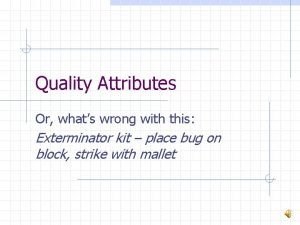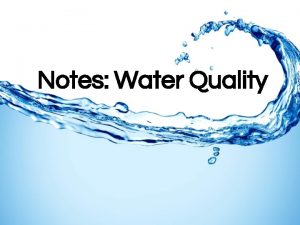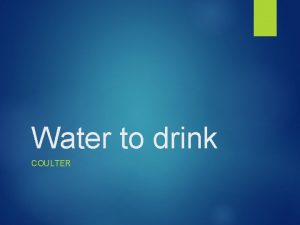Water Quality Monitoring Whats wrong with the water

























- Slides: 25

Water Quality & Monitoring

What’s wrong with the water? Explain any methods scientist use to determine healthy water

p. H (potential of hydrogen) Identifies the acid/base balance of water Ranges from 0 -14 The closer the number is to 0 the more acidic, the closer it is to 14 the more basic What do you think the normal range of water is? 6. 5 – 8. 5 Pure water is 7 – very healthy p. H is important to living things because: Living things grow and survive in a particular p. H environment


Dissolved Oxygen (DO) Amount of oxygen dissolved in water and is essential to healthy streams and lakes Measured in parts per million (ppm) Comes form photosynthesis All living organisms need oxygen, Which they get from water, so the Water systems are healthier when They have more DO.

Temperature The colder the water the more dissolved oxygen water can hold The warmer the water, the lesser amount of DO Very warm water can kill fish A healthy range is when water stays below 29*C

Nitrate and phosphate levels Needed by living plants and animals to build protein Nitrates Comes from things such as fertilizer, sewage, and leaking septic tanks Phosphates usually enter waterways from human and animal waste, laundry, cleaning and industrial waste Eutrophication: (Greek word meaning development) Over fertilization of water with nutrients. This occurs when water comes from runoff from farmlands, lawns, sewage, detergents, animal

Turbidity measures how cloudy the water is It can be caused by suspended solids such soil, sewage, and algae Particles in the water can prevent plants from getting enough sunlight to complete photosynthesis Water is more turbid = more cloudy less turbid = less cloudy

Let’s say: YOU WORK IN A GOLD MINE. $$$$$$$ Deep underground.

And the mine EXPLODES!

SOME LUCKY ESCAPE!

Many miners are trapped underground!

How do you know if it’s safe to go down in the mine?

A BIOINDICATOR!!!

Take a little canary for instance… Canary as a bio-indicator lower one down the mine.

Take a little canary for instance… Canary as a bio-indicator lower one down the mine.

When the canary flies into the mine, If the canary survives, it’s safe to go into the mine!

The canary is lowered into the mine, If the canary survives, it’s safe to go into the mine! The canary (BIOlogical life) INDICATES it’s SAFE!!!!!!

A live canary is a BIOINDICATOR that it’s safe to enter a damaged mine.

If a bio-indicator doesn’t survive, it isn’t safe! Canary doesn’t make it.

If a bio-indicator doesn’t survive, it isn’t safe! Canary doesn’t make it. Neither did the miners!

Bio-indicators Organisms used to assess ecosystems health Looking at the health of the organisms that are living in the water, can help determine the health of the water system Water that is healthy helps keep its organisms healthy. Diseased fish shows that the water system is unhealthy

Good vs. Bad Bioindicators A good bio-indicator does not easily adapt to a changing environment. These organisms stay within a small range and if you no longer see them in the body of water, this indicates a change in water quality A bad bio-indicator can live in a wide range of water quality and can change with its environment.

Which is the best bioindicator? Why? p. H Trout Bass Snail Perch Sala mand er 7 X X X 6. 5 X X 6 X X 5. 5 X X 5

A. Nutrients added to waterways through runoff, too many of these leads to Eutrophication B. Animals in this area must be able to adapt to wet and dry conditions, temperature, & salinity C. Organisms used to assess ecosystems health D. Increase in turbidity, increase temp, increase DO 5. Benthic Zone E. Colder water can hold more DO 6. Nitrates and F. The amount of particles suspended within water G. In this zone you can see where the continent ends H. This zone receives no sunlight, has most phytoplankton 8. Bioindicators I. The higher amount of this, the better the water quality 9. Intertidal J. Increase in pressure, decrease in temperature, life is supported from nutrients in vents K. The measure of how basic water is 1. DO 2. Neritic Zone 3. Temperature 4. p. H Phosphates 7. Turbidity Zone
 You put the wrong emphasis on the wrong syllable
You put the wrong emphasis on the wrong syllable National water quality monitoring council
National water quality monitoring council National water quality monitoring council
National water quality monitoring council National water quality monitoring conference
National water quality monitoring conference National water quality monitoring conference
National water quality monitoring conference Water and water and water water
Water and water and water water Whats wrong with niamh cullen
Whats wrong with niamh cullen Whats wrong with this graph
Whats wrong with this graph Whats wrong with this
Whats wrong with this Whats wrong with this photo
Whats wrong with this photo Learning objectives for revision
Learning objectives for revision Whats wrong
Whats wrong Whats wrong with this picture
Whats wrong with this picture Quality monitoring scorecard
Quality monitoring scorecard Quality monitoring scorecard
Quality monitoring scorecard Dqmf
Dqmf Wdqms
Wdqms Real time data quality monitoring
Real time data quality monitoring Permanent power quality monitoring equipment
Permanent power quality monitoring equipment Quality control and quality assurance
Quality control and quality assurance Plan quality management pmp
Plan quality management pmp Quality metrics pmp
Quality metrics pmp Quality assurance model in nursing management
Quality assurance model in nursing management Compliance vs quality
Compliance vs quality Basic quality concepts
Basic quality concepts Known as the fun uncle of the quality revolution
Known as the fun uncle of the quality revolution

